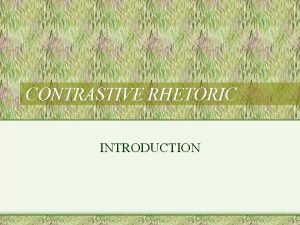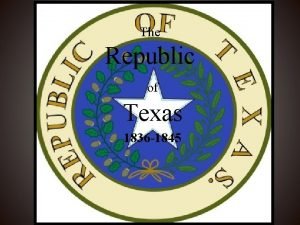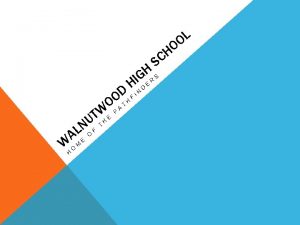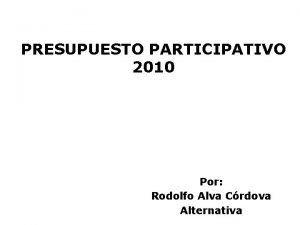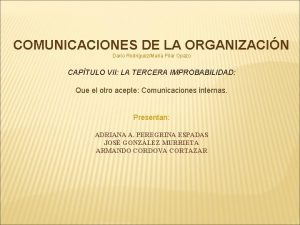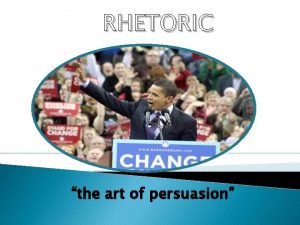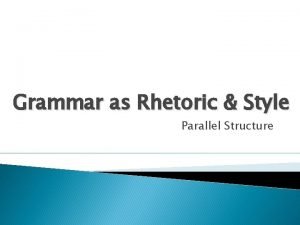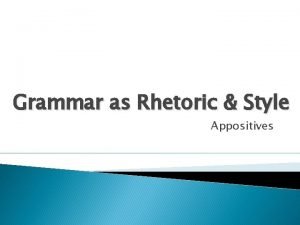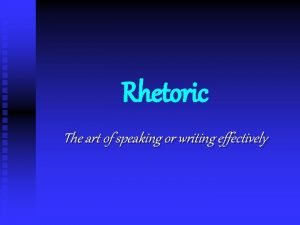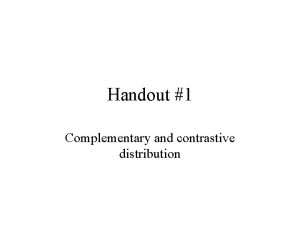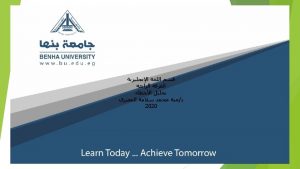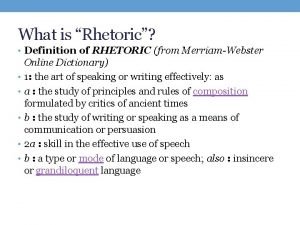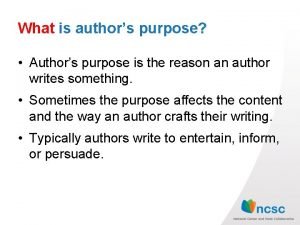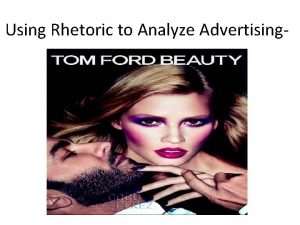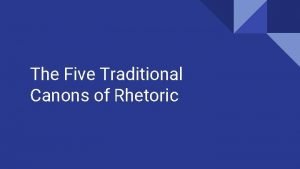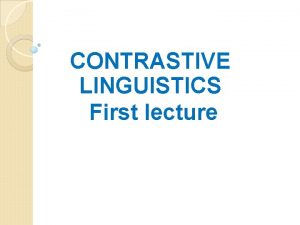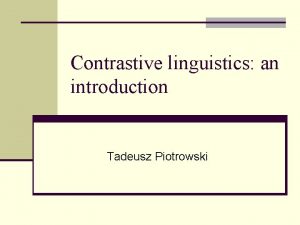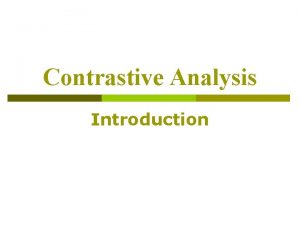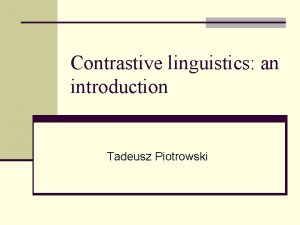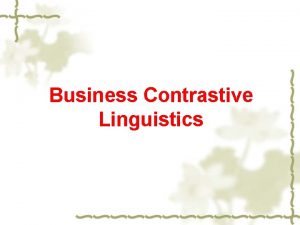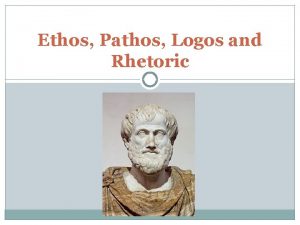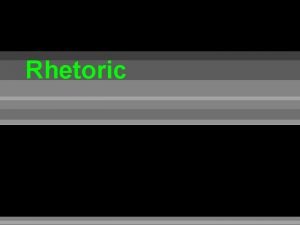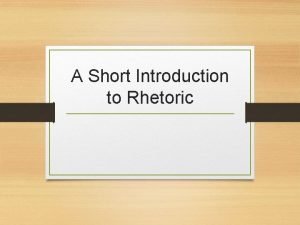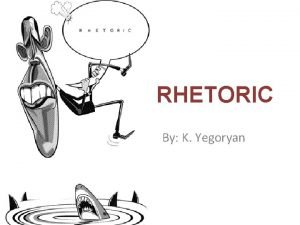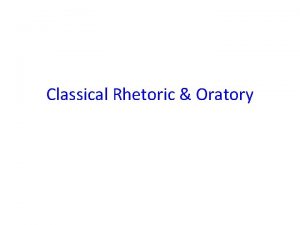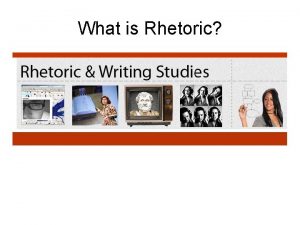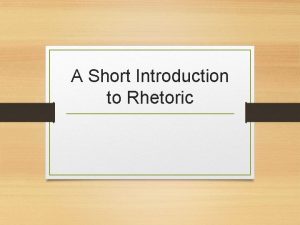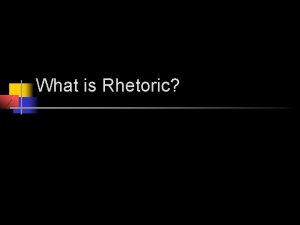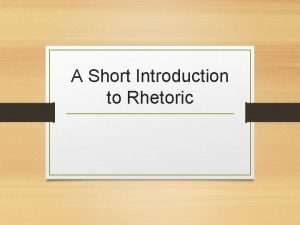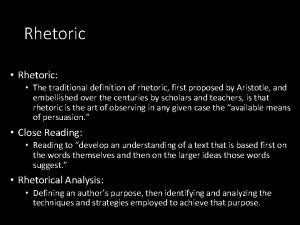Luis Cordova GENRE AND CONTRASTIVE RHETORIC Genre refers






















- Slides: 22

Luis Cordova GENRE AND CONTRASTIVE RHETORIC

Genre refers to a type of writing that serves a specific purpose and that is shared by a discourse community who share similarities – Example: recipes or an academic persuasive essay. It focuses on structure, purpose, and organization. Traditional rhetoric identifies exposition, argument, description, and narration as genres, but they are really modes because these text may use any number of combinations of these at the same time. Genre structure changes from one language to another, so limited knowledge of a genre can be problematic to an ELL. Genre and Contrastive Rhetoric, Hudson, Ch. 8

Bazerman 1997: 19 Genres are not just forms. Genres are forms of life, ways of being. They are frames for social action. They are environments for learning…. . genres shape thoughts we form and the communications by which we interact. Genre and Contrastive Rhetoric, Hudson, Ch. 8

Genres VS Register Genres such as the research or business report or recipes are finite structured texts, while registers such as the language of scientific or newspaper reporting represent more stylistic options. Ex: research articles are not a genre of scientific writing; rather they are focused on register and style. Genre and Contrastive Rhetoric, Hudson, Ch. 8

What’s the Point? Genres must be examined as representations of actions not with text structure alone. Genre and Contrastive Rhetoric, Hudson, Ch. 8

What do you think? Is a genre seen on a macro level, such as a narrative, or is it to be defined on the micro level of a letter to a friend describing a vegetable garden? Genre and Contrastive Rhetoric, Hudson, Ch. 8

Swales (1990: 45 -55) Genres are classes of communicative events, and what turns a collection of communicative events into a genre is the presence of shared communicative purpose. Swales’ emphasis on shared purpose rather than simply on similarities of form recognizes that texts that have the same form may represent separate genres. Genre and Contrastive Rhetoric, Hudson, Ch. 8

Goal-directed Communicative Products Genres represent goal-directed communicative products such as lab reports, working papers, indexes, letters of recommendation, grant proposals, and journal articles. Genre and Contrastive Rhetoric, Hudson, Ch. 8

Specialization; Functions Genre knowledge is linked to practice in specific areas such as how a biologist knows how to report lab results…Specializations create more distinctly restricted generic forms. Functions also generate genres. Power. Point are a prime example of a genre growing out of the presentation function. Genre and Contrastive Rhetoric, Hudson, Ch. 8

Genres Are Both Psychological and Social They represent the cognitive processing of internal schemata and structure as well as the appropriate application of socially prescribed genre categories for others who are familiar with the categories. Some of the authors take a structural (linguistic) approach to genre, while others take a functional (social) approach. Which view do you tend toward? Why? Genre and Contrastive Rhetoric, Hudson, Ch. 8

Discourse Community 1. has a set of common goals 2. has mechanisms of intercommunication among its members 3. uses its participatory mechanisms primarily to provide information and feedback 4. has acquired some specific lexis As an example of discourse community, Swales (1990) mentions a hobby group called the Hong Kong Study Circle (HKSC). This group has as its goals the fostering of interest and knowledge about the stamps of Hong Kong (a group that share similarities). Genre and Contrastive Rhetoric, Hudson, Ch. 8

Genres can develop different structure, as seen below. Genre and Contrastive Rhetoric, Hudson, Ch. 8

Contrastive Rhetoric Genres and text structure are culture specific. Different cultures develop different rhetorical argument patterns, which may interfere with second language reading and writing. Contrastive rhetoric has been useful in understanding reading problems among ELL. Genre and Contrastive Rhetoric, Hudson, Ch. 8

Cross Cultural Differences Genre and Contrastive Rhetoric, Hudson, Ch. 8

Findings on Differences Hinds (1987) proposed that Japanese writing demands more of the reader, in terms of coherence, whereas the rhetorical form preferred in the West places the burden of exposition on the writer. Genre and Contrastive Rhetoric, Hudson, Ch. 8

More Findings Zhu (1997, 2000) has examined the structure of Chinese sales letters and has contrasted them with English sales letters… The English sales letters tended to contain a headline at the beginning of the letter such as ‘The Latest Appliance on up to 18 Months Interest Free Credit’ or a PS notation, whereas the Chinese letters did not contain these moves. In contrast, the Chinese business letters tended to include greetings. Genre and Contrastive Rhetoric, Hudson, Ch. 8

Duszak (1994), Golebiowski (1998) Duszak (1994) and Golebiowski (1998) both discuss how Polish articles in academic publications lack divisions into sections such as Introduction, Methods, Results, Conclusion, Discussion, but rather feature unsegmented and continuous text. Golebiowski found material normally contained in the introduction section of English articles to be distributed throughout the Polish texts. Genre and Contrastive Rhetoric, Hudson, Ch. 8

Instructional Approaches Hyon (2002) describes a genre-based reading program of instruction for university students whose first language is other than English. The program involved the genres of a hard news story, a magazine feature article, a textbook, and a research article. Discussions focused around the text content, structure, language style, and purpose. Genre and Contrastive Rhetoric, Hudson, Ch. 8

More Instructional Approaches Reppen (1995) piloted a genre-based unit with fifth-grade public school students in a low socioeconomic area school. The teacher modeled new rhetorical patterns for the students to practice. The genre forms included narrative, descriptive, persuasive, and expository. The students discussed the attributes of each genre and contrasted them. Genre and Contrastive Rhetoric, Hudson, Ch. 8

Summary and Conclusions Teaching genres is more complex and involves a more social look at how the reader interacts with the context of the text…it needs to teach the reader to situate the text in a purposeful context. Genre is a central concept in understanding how text is organized and what purpose motivates the text’s existence. Genre and Contrastive Rhetoric, Hudson, Ch. 8

Summary and Conclusions Genres are closely linked to the discourse communities they are part of. Their success is linked to how the discourse community accepts and interprets them. Genres , being social inventions, vary in their representations across cultures. Readers from different languages and cultures need to recognize and be to the potential differences to become accomplished readers. Genre and Contrastive Rhetoric, Hudson, Ch. 8

Works Cited Hudson, Thomson. Teaching Second Language Reading. Oxford University Press, 2007
 Contrastive rhetoric definition
Contrastive rhetoric definition Córdova rebellion
Córdova rebellion Bric bank cordova
Bric bank cordova Emirat de cordova
Emirat de cordova Hotels near walnutwood high rancho cordova ca
Hotels near walnutwood high rancho cordova ca Cordova alska
Cordova alska Rodolfo alva cordova
Rodolfo alva cordova Armando cordova cortazar
Armando cordova cortazar Grande moschea di cordova
Grande moschea di cordova Arte abstracto cromatico
Arte abstracto cromatico Rhetoric: the art of persuasive writing and public speaking
Rhetoric: the art of persuasive writing and public speaking Rhetoric parallelism
Rhetoric parallelism Grammar as rhetoric and style exercise 1 answers
Grammar as rhetoric and style exercise 1 answers Is the art of speaking or writing effectively.
Is the art of speaking or writing effectively. Contrastive distribution and complementary distribution
Contrastive distribution and complementary distribution Differences between contrastive analysis and error analysis
Differences between contrastive analysis and error analysis Types of intralingual errors
Types of intralingual errors You eat what you touch
You eat what you touch Merriam webster rhetorical devices
Merriam webster rhetorical devices What is the author’s purpose in these frames?
What is the author’s purpose in these frames? What is rhetoric
What is rhetoric 3 types of rhetoric
3 types of rhetoric Canons of rhetoric
Canons of rhetoric
